Graubindiger Augenfleckbock
| Graubindiger Augenfleckbock | ||||||||||||
|---|---|---|---|---|---|---|---|---|---|---|---|---|

Graubindiger Augenfleckbock |
||||||||||||
| Systematics | ||||||||||||
|
||||||||||||
| Scientific name | ||||||||||||
| Mesosa nebulosa | ||||||||||||
| ( Fabricius , 1781) |
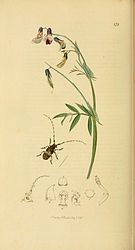
|
||
| Fig. 1: Top view | ||

|
||
| Fig. 2: Camouflage |
Fig. 3: End sensor element |
Fig. 4: Engraving by John Curtis |
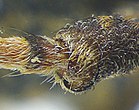
|

|
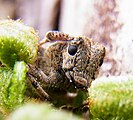
|
|
Fig. 5: End of 1st and 2nd antenna segment |
Fig. 6: head, eye |
Fig. 7: Front view |
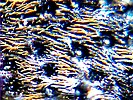
|

|
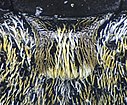
|
| Fig. 8: Puncturing |
Fig. 9: Head, button |
Fig. 10: Label |
The Gray Cohesive eyespot Bock also binding eyespot Bock , ( Mesosa nebulosa ) is a beetle from the family of the longhorn beetle and the subfamily Lamiinae . The genus Mesosa is represented by three species in Europe . Worldwide there are over 100 species in five subgenera. The beetle is listed in the Red Lists of Bavaria and Schleswig-Holstein as well as Germany under category 3 (endangered). In Brandenburg , North Rhine-Westphalia and Saxony-Anhalt , the species is considered endangered (Category 2). In Saxony and Thuringia , the beetle is classified as extremely rare and potentially endangered . In Mecklenburg-Western Pomerania, however, it is listed as not endangered .
Notes on the name
The beetle was first described by Fabricius in 1781 under the name Lamia nebulosa as the 13th species of the genus Lamia . The species name nebulōsa ( Latin cloudy) refers to the color of the wing covers, which Fabricius describes as different dark rust colors with gray side spots on the edge (Latin fusco ferrugineoque variis, macula marginati cinerea). The generic name Mesōsa (from ancient Greek μέσος "mésos" for "middle") probably refers to the size of the animal, which is already given in the short first description as media (Latin medium). The name osprey refers to the genus Mesosa . The beetle presented here has no eye spots. The addition of binding or gray binding refers to the color of the wing covers, in which a gray band is indicated.
Description of the beetle
The medium-sized beetle has a stocky cylindrical shape and is usually between nine and fifteen millimeters long. The chitin skeleton is predominantly black, legs and antennae are usually brown. The color and structure of the skeleton are almost completely covered or concealed by the hair. The hairiness makes the beetle appear very variably striped to spotty in various shades of brown and gray. This makes for excellent camouflage (Fig. 2). Only moderately dense and irregularly scattered large and shallowly recessed round bare points (Fig. 8) show the black basic color and appear like grains if the magnification is insufficient.
The head is - typical for the subfamily - inclined downwards perpendicular to the body axis. Its entire length has a recessed midline that disappears near the pronotum (Figs. 6 and 7). The sloping front part is flattened and slightly indented transversely, the upper lip and mandible are slightly raised. The mouthparts are shown on the engraving by John Curtis (Fig. 4 below, 1 upper lip, 2 upper jaws, 3 lower jaws with jaw feeler, 4 chin with lower lip and lip feeler). The pointed end link of the jaw probe (Fig. 9, the outer probe) separates the subfamily from other subfamilies of longhorn beetles. The high-lying eyes are flat and, due to the deflection of the antennae on the front, are strongly outlined, almost divided into two parts (Fig. 6). The first of the eleven antennae is thickened like a club on the outside. In front of the end it has a fine semi-circular bar. Behind this, the end of the feeler link is cut off flat towards the root of the second feeler link. The crescent-shaped cut surface thus formed is, like the bar, difficult to recognize due to the hair (Fig. 5). The second link is short, but longer than it is wide, the following links are long and slender, they become increasingly slender towards the outside. The antennae clearly protrude beyond the end of the body in the male, but hardly in the female. They are hairy brown, from the third link gray ringed near the base and long ciliate on the underside. The terminal link of the antennae is five to six times as long as it is wide in the male, and at most three times as long as it is wide in the female (Fig. 3).
The pronotum is slightly wider than the head and a little wider than it is long. The sides are only slightly arched outward and do not have a thorn, which makes the pronotum appear somewhat cylindrical. About a quarter of its length from the rear edge it has an inconspicuous wart-like elevation. Before that, it is slightly indented along the center line, a similar shallow groove lies to the right and left of the elevation. However, this structure is completely inconspicuous due to the hairiness. The top of the pronotum is like the top of the head with longitudinal stripes lighter and darker hairy. This striation continues on the top of the head. The pronotum has no eye spots. The pronotum has very weak margins in front and behind. The dots are a little less distinctive than on the wing covers.
The label (Fig. 10) is roughly square and slightly depressed at the front. It is hairy yellow or red-yellow.
The elytra are barely twice as long as together wide and at the base significantly wider than the pronotum. They are about four times as long as the pronotum and are bluntly rounded at the end. The wing covers also have inconspicuous longitudinal grooves and keels. Only the impression in the shoulder area with the resulting angular shoulder corner and the opposite elevation is noticeable. The puncture is similar to that of the pronotum, it becomes less prominent towards the back. Each wing cover has a large, light spot in the middle. These spots connect via the sash of the wing cover to form a jagged, unevenly colored band.
The legs are long and strong. The longitudinal furrow typical of the subfamily on the inside of the front splint is difficult to recognize because of the hairiness. The tarsi appear four-limbed because one limb is only recognizable as a thickening at the base of the claw limb. The first link of the hind tarsi is hardly as long as the third. Rails and tarsi appear curled due to the different color of the hair.
Through the combination of the four characteristics of shape, missing thorn on the pronotum, bracing of the first antennae and missing eye-spots on the pronotum, the species is clearly identified within Central Europe.
larva
In the last stage, the larva becomes up to 23 millimeters long. As with all larvae of the subfamily, the head capsule is much longer than it is wide. The 9th abdominal segment has a thorn that does not sit on a small chitin plate. The forehead is grooved lengthways in the middle.
biology
The species lives in deciduous forests and forest edges. For Central Europe it is stated that it mainly develops in stronger, rotted, still hanging or already lying branches, but also in dead trunks, in stumps or in brushwood. Almost all deciduous trees are presumably accepted.
In England over twenty host plants are mentioned. The polyphagous larva is found there almost exclusively in dead tree tops. Pupation takes place in midsummer. The adults hatch in July and August, but overwinter in the pupa cradle and appear in March the following year. Development takes two to three years. The beetle obviously does not visit flowers. The larvae are parasites of Dolichomitus messor Grav. Helcon annulicornis Nees , Pyracmon melanurus Holmgr. and Xorides irrigator Fabricius cited.
A comparison of different forest types including the height above the ground showed that Mesosa nebulosa is predominantly but not exclusively a tree dweller. In addition, a certain concentration of oaks was found, which, however, were storm-damaged.
distribution
The species is widespread in almost all of Europe, becoming rarer towards the north. It is also found in North Africa, the Middle East, and the Caucasus. It is absent on most of the islands.
literature
- Heinz joy, Karl Wilhelm Harde, Gustav Adolf Lohse (ed.): The beetles of Central Europe . tape 9 . Cerambycidae Chrysomelidae . Spektrum Akademischer Verlag, Munich 1999, ISBN 3-8274-0683-8 (first edition: Goecke & Evers, Krefeld 1966). P. 77
- Klaus Koch : The Beetles of Central Europe . Ed .: Heinz Freude . tape 3 : ecology . Goecke & Evers, Krefeld 1992, ISBN 3-87263-042-3 . P. 40
- Luc Auber: Coléoptères de France Fascicule III Edition N.Boubée & Cie, Paris 1955 p. 24
Individual evidence
- ↑ John Curtis: British Entomology Vol. 2 Plate 172, July 1827
- ↑ a b c Mesosa nebulosa in Fauna Europaea. Retrieved January 16, 2014
- ^ Mesosa at Fauna Europaea. Retrieved January 16, 2014
- ↑ Pages on the genus and sub-genres at BioLib [1] [2] [3] [4] [5] [6]
- ↑ Red lists at Science4you
- ↑ Sigmund Schenkling: Explanation of the scientific beetle names (species)
- ↑ Fabricius: Species insectorum exhibentes eorum differentias specificas .. Hamburg, Kiel 1781 vol. 1 p. 218 at GDZ p. 230: 218
- ↑ Sigmund Schenkling: Explanation of the scientific beetle names (genus) .
- ↑ a b c d Mulsant: Histoire naturelle des coléoptères de France - Longicornes Paris 1862–1863 in BHL p. 334 as M. nubila and the genus Mesosa p. 331
- ^ K. Escherich: The forest insects of Central Europe 2nd bath. Berlin 1923 at BHL
- ^ R. Raymond, R. Uhthoff-Kaufmann: "The Genera Lamia F., Mesosa Latr. And Leiopus Serv. (Col .: Lamiidae) in the British Islands" in The Entomologist's Record an Journal of Variation Vol. 103 January / February 1991 at BHL p. 74f
- ↑ Thomas Coch, Matthias Vögeli: Crown- dwelling longhorn beetles as decision-making aids for the revitalization of former medium-sized forests in Swiss Journal of Forestry Volume 157, Issue 8 (2006) pp. 318-324 Print- ISSN 0036-7818 Online- ISSN 2235-1469 [7]
- ^ Adolf Horion : Faunistics of the Central European Beetles, Vol. XII . Überlingen-Bodensee 1974, p. 164

